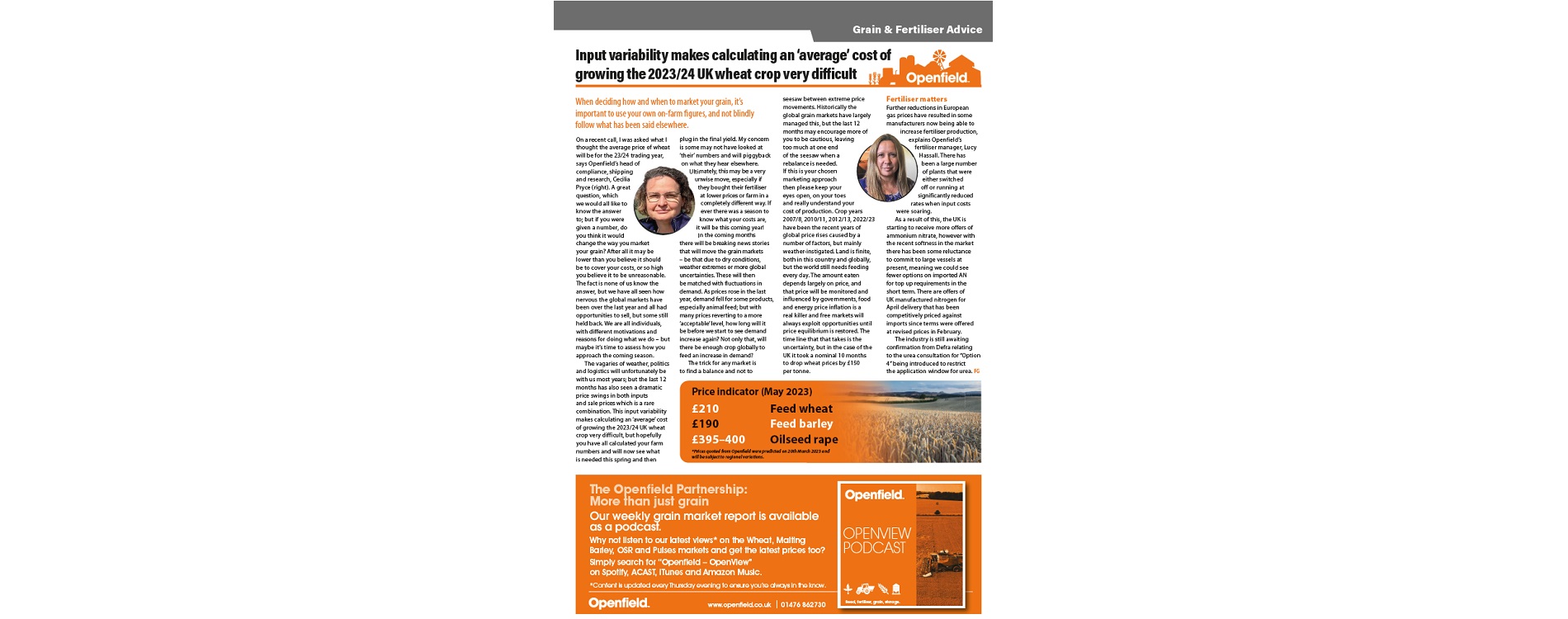Input variability makes calculating an ‘average’ cost of growing the 2023/24 UK wheat crop very difficult
When deciding how and when to market your grain, it’s important to use your own on-farm figures, and not blindly follow what has been said elsewhere.
On a recent call, I was asked what I thought the average price of wheat will be for the 23/24 trading year. A great question, which we would all like to know the answer to; but if you were given a number, do you think it would change the way you market your grain? After all it may be lower than you believe it should be to cover your costs, or so high you believe it to be unreasonable.
The fact is none of us know the answer, but we have all seen how nervous the global markets have been over the last year and all had opportunities to sell, but some still held back. We are all individuals, with different motivations and reasons for doing what we do – but maybe it’s time to assess how you approach the coming season. The vagaries of weather, politics and logistics will unfortunately be with us most years; but the last 12 months has also seen a dramatic price swings in both inputs and sale prices which is a rare combination. This input variability makes calculating an ‘average’ cost of growing the 2023/24 UK wheat crop very difficult, but hopefully you have all calculated your farm numbers and will now see what is needed this spring and then
plug in the final yield. My concern is some may not have looked at ‘their’ numbers and will piggyback on what they hear elsewhere. Ultimately, this may be a very unwise move, especially if they bought their fertiliser at lower prices or farm in a completely different way. If ever there was a season to know what your costs are, it will be this coming year!
In the coming months there will be breaking news stories that will move the grain markets – be that due to dry conditions, weather extremes or more global uncertainties. These will then be matched with fluctuations in demand. As prices rose in the last year, demand fell for some products, especially animal feed; but with many prices reverting to a more ‘acceptable’ level, how long will it be before we start to see demand increase again? Not only that, will there be enough crop globally to feed an increase in demand? The trick for any market is to find a balance and not to
seesaw between extreme price movements. Historically the global grain markets have largely managed this, but the last 12 months may encourage more of you to be cautious, leaving too much at one end of the seesaw when a rebalance is needed. If this is your chosen marketing approach then please keep your eyes open, on your toes and really understand your cost of production. Crop years 2007/8, 2010/11, 2012/13, 2022/23 have been the recent years of global price rises caused by a number of factors, but mainly weather-instigated. Land is finite, both in this country and globally, but the world still needs feeding every day. The amount eaten depends largely on price, and that price will be monitored and influenced by governments, food and energy price inflation is a real killer and free markets will always exploit opportunities until price equilibrium is restored. The time line that that takes is the uncertainty, but in the case of the UK it took a nominal 10 months to drop wheat prices by £150 per tonne.
Fertiliser matters
Further reductions in European gas prices have resulted in some manufacturers now being able to increase fertiliser production. There has been a large number of plants that were either switched
off or running at significantly reduced rates when input costs were soaring. As a result of this, the UK is starting to receive more offers of ammonium nitrate, however with the recent softness in the market there has been some reluctance to commit to large vessels at present, meaning we could see fewer options on imported AN for top up requirements in the
short term. There are offers of UK manufactured nitrogen for April delivery that has been competitively priced against imports since terms were offered at revised prices in February. The industry is still awaiting confirmation from Defra relating to the urea consultation for “Option 4” being introduced to restrict the application window for urea.




